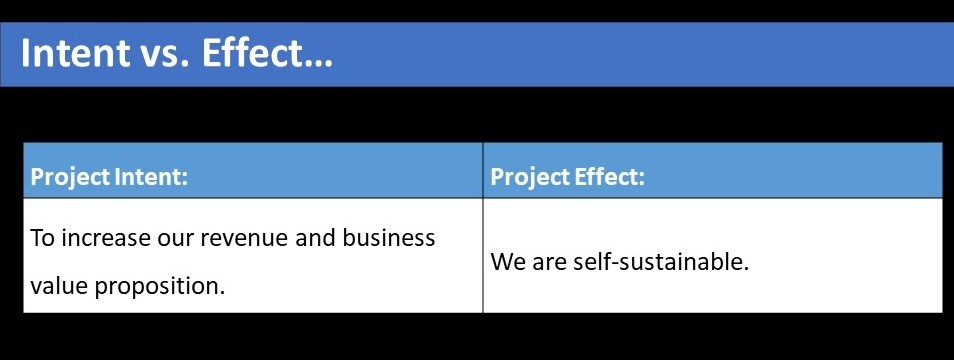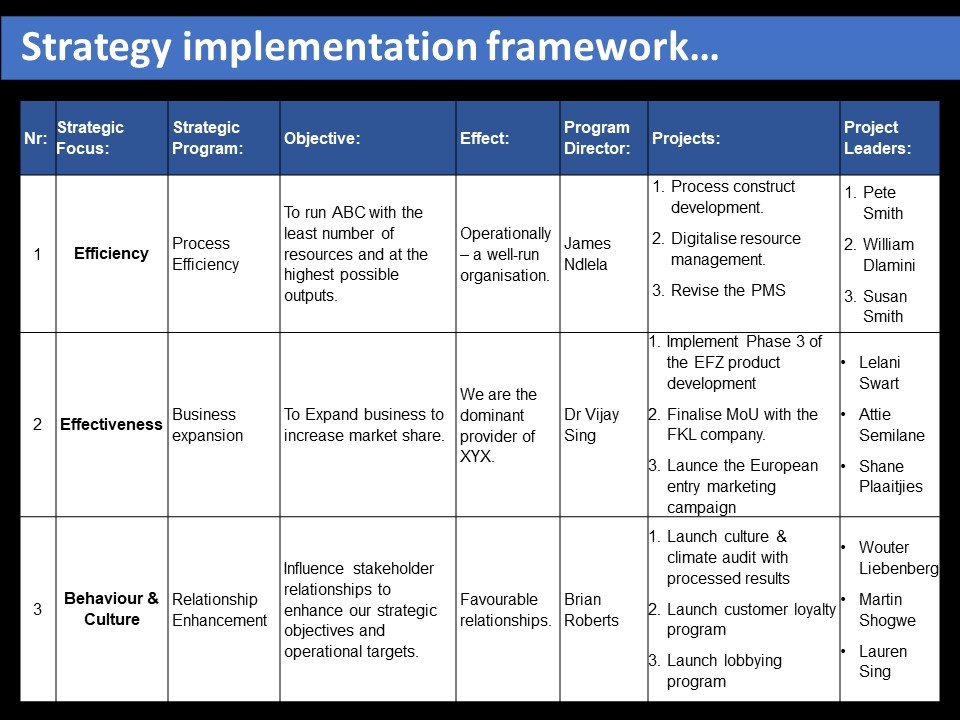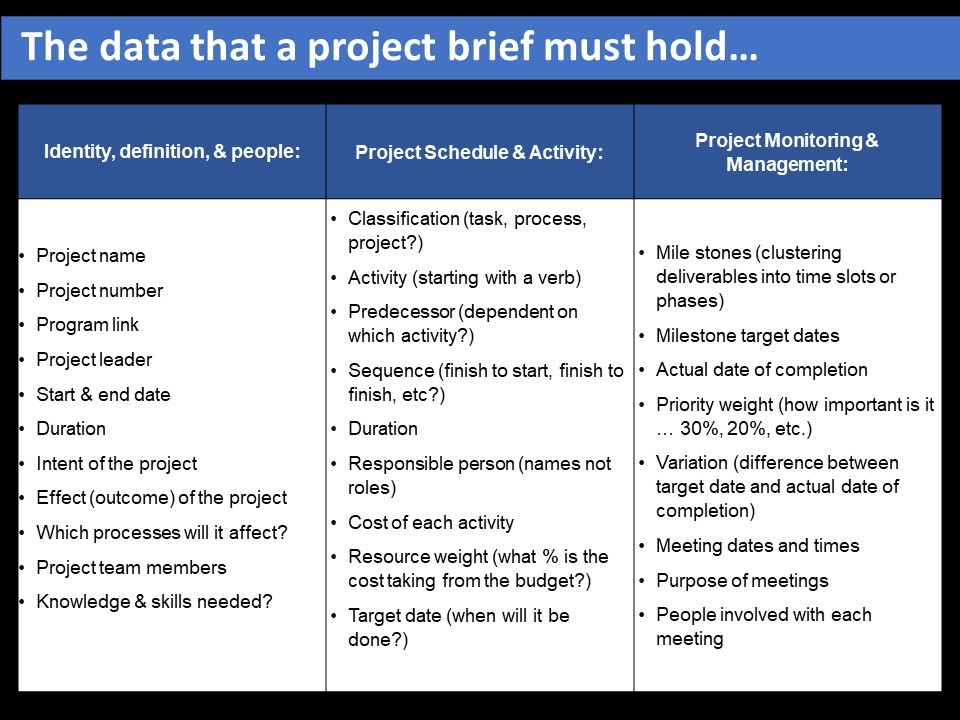The Orgtology Blog
Work breakdown structure for strategic programs
A work breakdown structure (WBS) is a detailed plan on how to execute an intent. WBS's are used in project management. We do not use the term in process management because there we work with cyclic flow. In projects we must get things done as quickly as possible. With processes it is more about increasing the efficiency of cycle times. That is why projects have critical paths and processes do not.
In strategy we have found that the best way of execution is through project management methods. This ensures that there is science to the planning of execution. Projects have due dates, timelines, milestones, a critical path, allocated resources, responsible teams, etc. These are the things necessary for execution of strategy. Therefore, a proper WBS is key to strategic success.
Basic assumption on strategic work breakdown
If we execute strategic programs via project management methods, then strategy will need a work breakdown structure that runs programs through projects. This is because project management method is the most tested and proven way to get any non-repetitive thing done. Also, a proper work breakdown structure is the best way to understand a project, its flow, critical activity, resources need, etc.
In orgtology we turn strategic objectives into strategic programs. Each program has several projects. These projects are the activity of the program. Org mostly holds between two and five strategic objectives. More than that makes the strategy hard to control. To execute the projects, we use resources and activity.
What is a strategic program?
A strategic program is a high-level plan that aims to achieve the vision of Org.
To develop a strategic program, we must answer the following three questions:
- What is working and what is not (ROET)?
- How are we currently doing (targets)?
- How do we define the future (5V Model)?
In the ROET analysis we look at Relationships, Opportunities, Efficiency, and Threats. These items will help us understand what is working well and what is not. Next, we set operational targets for our strategic period. Lastly, we develop our 5V Model to create a strategic ladder towards our ultimate dream. To guide us in defining our strategic objectives, we ask the following questions:
- ROET – what must we change to ensure efficient operations?
- Targets – will we organically achieve these through our operational processes, or must something change?
- 5V Model – what must change so that we can move faster towards our ultimate dream?
I explain ROET, targets, and the 5V model in other essays – www.orgtology.org
There are three broad dimensions that will encompass all the changes that Org must make. We answer the above questions on ROET, targets, and 5V within the following dimensions:
- Performance (efficiency).
- Relevance (effectiveness).
- Culture and behaviour.
Within the above framework, one should produce between two to five well-defined strategic objectives. More than that will make the strategy hard to execute. In turn, each strategic objectives will become a strategic program.
The strategic program is thus a high-level project that dedicates all resources at its disposal to the execution of a strategic objective.
Defining a strategic objective and its execution structure
Strategy expresses an intent. A strategic objective is part of this intent. Therefore, we write a strategic objective as a future desired state. E.g., "To be…", "To reduce…", "To ensure…", etc. Through strategic objectives, we define the future.
To give clarity to our end-result, we must also give each objective an outcome. This is the effect that the objective aims to have. Table 1 below shows the difference between an objective and an effect...
Table 2 shows how we link strategic focus with a strategic program. As mentioned, when creating a strategy, we use the following strategic focus areas as baseline:
- Efficiency
- Effectiveness
- Culture and behaviour
Table 2 also shows how we unpack these programs as projects. The objective defines the program, whilst the projects execute it. Program Directors will oversee Project Leaders.
Executing the strategy through project management methods
Worldwide project management methodology is the best way to execute strategy. The traditional "bullet pointed" action plan strategy documents have shown to have an immensely high failure rate. Projects work because it holds a detailed execution plan. It is thus designed for execution.
The execution of strategy begins with a project brief. As discussed below, the project brief is the project teams first introduction and guidance to the project. From here their task is to unpack the timelines, milestones, a critical path, resources, target dates, etc. I.e., once the project brief is unveiled to the project team, they must create a detailed project plan.
There are a variety of digital project management tools on the market. In my experience these tools reduce human error and mostly make advanced statistical analysis possible. Personally, I use Excel spreadsheets to manage my projects, but do not recommend this to novice users. Whether you use the PMBoK or Prince; or follow lean manufacturing or six sigma, etc., is a matter of choice. There is a core theory that all these bodies and applications must follow. E.g., whatever the method, there will be a critical path.
Failure to execute a strategy will directly reflect on an inability to manage projects. The aim of any project is to craft a future state. Leaders drive the future. Therefore, failure to execute strategy is a failure to lead.
The importance of a project brief
When we develop strategy for clients, crafting strategic objectives is the creative part. From that point onward, it becomes a matter of planning the execution. This begins with a project brief.
The project brief introduces the project team to the project planning and execution process. It gives detailed information on what, why, who, where, when, and how we will do things. It covers the following broad areas:
- Identity, definition, and people.
- Project schedule & activity.
- Project monitoring & management.
Table 3 below shows the data that each of the areas above must collect. I have also attached a template project brief.
Program team vs. the project team
As explained, a program is a strategic objective that drives numerous projects. Thus, we use projects to execute programs.
The program team will consist of the Program Director and all the Project Leaders for linked projects. The purpose of this team is oversight. Jointly, execution of all the projects and their expenses are the execution and expense for the program. The program team must discuss and lead the program objective on a regular basis.
The project team is the Project Leader and all the people who will execute activity within the project. In so, the purpose of the project team is to execute part of a strategic objective.
As a rule of thumb, it is best for project teams to meet weekly, until they complete the project. It should be enough for program teams to meet monthly. It is important for program teams that the following data is available prior to their meeting…
- Overall program execution – as a %.
- Individual execution % for each project.
- Overall program expense to date – as an amount and a % of the strategic budget.
- Individual expense to date of each project – as an amount and as a % of the program budget.
- Execution efficiency – are we completing activities before, on, or after the due dates?
- Budget efficiency – are we under-, over-, or correctly spending the budget?
Conclusion
An Orgtologist will approach the strategic process in three phases. Firstly, it is about understanding. To do this we use the ROET analysis, 5V Model, and key operational targets. Once this phase is done, we begin the creative process. This is where we design strategic direction and objectives. The last phase is to create a detailed execution plan. We draft this execution plan through a work breakdown structure (WBS). Some of the items that one must unpack in a WBS are dependency flow of activity, duration, responsible people, resources needed, etc.
In so, a WBS is the last critical phase before Org can execute its strategy. Without a detailed WBS, execution becomes a blindfolded fishing trip. In my experience traditional strategies are mostly not executed because of their flimsy bullet point-based action programs. There are other reasons as well, such as not splitting strategic from operational activity, etc. Yet, I would say that lack of a thorough WBS is the main reason.
Clients often tell me that they have problem in strategy execution. When I ask them to show me their WBS, there is mostly none. The reality is that strategy execution is easy. Simply complete the projects on time, on budget, and on target. Not doing this is a leadership problem.

Join the Orgtologist Certification Program (OCP) - Empowering Executive Teams Worldwide
Copyright
© Derek Hendrikz: 2021-11-07
When you subscribe to the blog, we will send you an e-mail when there are new updates on the site so you wouldn't miss them.





